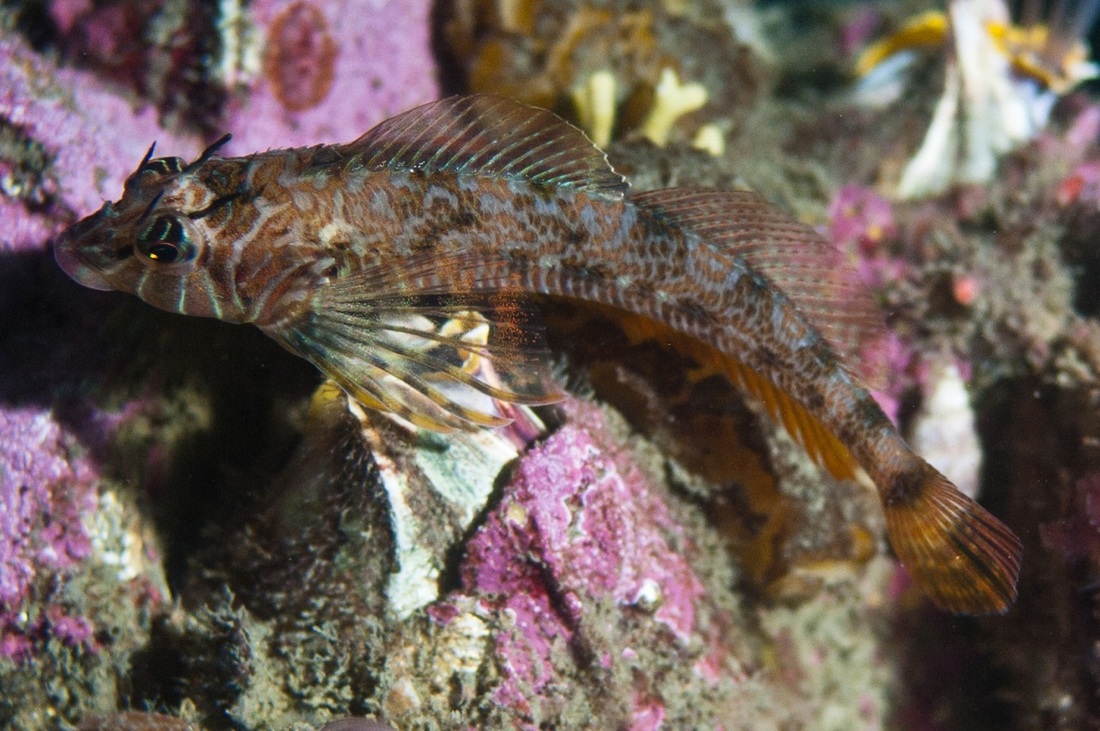Longfin sculpin • Jordania zonope

Photo by Mike Munroe
Identification
The longfin sculpin is named for its long anal fin. This elongated yellow or orange fin contrast brightly against an olive green body marked by dark red wavy bands across the back. Three pale bands below each eye create a striped effect on the head. This sculpin has a slender body and reaches 15 cm in length.
Habitat & Range
The longfin sculpin inhabits rocky reefs, in caves and crevices, and among kelp from the intertidal to 60 m depth. It is frequently spotted lying along vertical rock faces and cavern walls. Its range extends from central Alaska to central California.
Intriguing Info
This active species is very territorial during the breeding season. The male guards the egg clusters.
iNaturalist
https://www.inaturalist.org/taxa/222465-Jordania-zonope
The longfin sculpin is named for its long anal fin. This elongated yellow or orange fin contrast brightly against an olive green body marked by dark red wavy bands across the back. Three pale bands below each eye create a striped effect on the head. This sculpin has a slender body and reaches 15 cm in length.
Habitat & Range
The longfin sculpin inhabits rocky reefs, in caves and crevices, and among kelp from the intertidal to 60 m depth. It is frequently spotted lying along vertical rock faces and cavern walls. Its range extends from central Alaska to central California.
Intriguing Info
This active species is very territorial during the breeding season. The male guards the egg clusters.
iNaturalist
https://www.inaturalist.org/taxa/222465-Jordania-zonope
References
Froese, R. and Garilao, C.V. Jordania zonope Starks, 1895 Longfin sculpin. FishBase. Accessed 19/12/2014.
Harbo, R. M. (1999). Whelks to whales: Coastal marine life of the Pacific Northwest. Madeira Park, BC: Harbour Publishing. P. 211.
Lamb, A. and Edgell, P. Coastal Fishes of the Pacific Northwest. Revised. (2010). Madeira Park, BC: Harbour Publishing. Pp. 216-217.
Lamb, A., and Hanby, B. (2005). Marine Life of the Pacific Northwest [electronic version]. Madeira Park, BC: Harbour Publishing.
Authors and editors of page
Kelly Fretwell and Brian Starzomski (2014).
Froese, R. and Garilao, C.V. Jordania zonope Starks, 1895 Longfin sculpin. FishBase. Accessed 19/12/2014.
Harbo, R. M. (1999). Whelks to whales: Coastal marine life of the Pacific Northwest. Madeira Park, BC: Harbour Publishing. P. 211.
Lamb, A. and Edgell, P. Coastal Fishes of the Pacific Northwest. Revised. (2010). Madeira Park, BC: Harbour Publishing. Pp. 216-217.
Lamb, A., and Hanby, B. (2005). Marine Life of the Pacific Northwest [electronic version]. Madeira Park, BC: Harbour Publishing.
Authors and editors of page
Kelly Fretwell and Brian Starzomski (2014).




